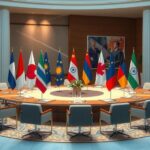Conflicts
Politics
ASIA, BLACK SEA, DEFENCE, DONALD TRUMP, DUBAI, EUROPE, EUROPE/ASIA, KREMLIN, KURSK, KY, KYIV, MILITARY, MILITARY SUPPORT, MOSCOW, NORTH AMERICA, PUTIN, RIA - NOVOSTI, RIYADH, RUSSIA, RUSSIA-UKRAINE WAR, RUSSIAN INVASION OF UKRAINE, SAUDI, SAUDI ARABIA, SUDZHA, TASS, U. S, UKRAINE, UNITED ARAB EMIRATES, UNITED STATES, VLADIMIR PUTIN, WAR, WHITE HOUSE, ZE, ZELENSKYY
Omar El-Sharif
U.S. and Russia Engage in Ceasefire Negotiations Amid Ongoing Conflict
U.S. and Russian officials are negotiating a potential partial ceasefire in Ukraine, following differing interpretations of protected targets. Ukraine’s President Zelenskyy seeks further assurances, while Russia accuses Ukraine of violating ceasefire agreements. Concurrently, a cyberattack on Ukrainian railways and ongoing military actions illustrate the continuing volatility of the situation, with calls for international pressure on Russia persisting.
The United States and Russia engaged in discussions on a proposed partial ceasefire in Ukraine, following separate talks with Ukrainian representatives. Accusations have arisen from both sides regarding the undermining of pause efforts in the prolonged conflict. A limited ceasefire was tentatively agreed upon, although there are differing interpretations regarding protected targets, with the White House emphasizing “energy and infrastructure,” while the Kremlin focused on “energy infrastructure” alone. Ukrainian President Volodymyr Zelenskyy seeks assurances for railways and ports as well.
The negotiations are expected to address these discrepancies and consider a ceasefire in the Black Sea to safeguard commercial shipping. Meetings commenced in Saudi Arabia, with ongoing consultations anticipated. Kremlin spokesman Dmitry Peskov indicated that Russian forces are adhering to an order from President Vladimir Putin to cease attacks on energy facilities for 30 days, although he accused Ukraine of undermining this ceasefire through military actions.
As hostilities persist, Zelenskyy criticized the ongoing attacks and called for the United States and its allies to increase pressure on Russia. He expressed Ukraine’s willingness to pursue a 30-day ceasefire but noted that Putin’s condition for a complete halt—ending arms supplies to Ukraine and suspending military mobilization—is unacceptable.
Trump’s special envoy indicated optimism for progress from the discussions. Meanwhile, China’s Foreign Ministry categorically denied any plans to send peacekeeping forces to Ukraine, clarifying its consistent stance on the crisis. Though China maintains trade relations with Russia, it has not supplied weapons or personnel.
Ukrainian state railway operator Ukrzaliznytsia experienced a significant cyberattack, although train operations remained unaffected. The company is working on restoring its online systems. Additionally, Ukraine’s military claimed responsibility for the destruction of Russian military helicopters using American-supplied weaponry. Russian drone attacks have continued, resulting in civilian injuries in various regions.
As both nations continue their negotiations, the conflict’s volatility remains evident with ongoing military engagements and cyber threats, affecting the lives of civilians caught in this prolonged dispute.
The recent negotiations between the United States and Russia on a potential ceasefire in Ukraine highlight the complexities of establishing peace in the region. While Ukraine remains open to a limited ceasefire, significant conditions proposed by Russia complicate the situation. Furthermore, ongoing cyberattacks and military operations continue to affect civilians, underscoring the urgency for a resolution. The involvement of international stakeholders, such as China and the U.S., plays a pivotal role in shaping the future course of action in this enduring conflict.
Original Source: time.com








Post Comment